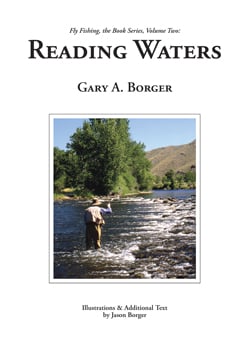Review: “Reading Waters”
Gary Borger’s reputation as a gifted angler and writer is pretty much set in stone. He’s an observant and canny (maybe even uncanny) fisherman, and he’s been well-tutored by a lifetime on the water. Anything he puts his hand to is worth investigating.
I’ve been reading Borger’s work for 20-odd years, and I haven’t read anything of his that is as packed with useful information as Reading Waters. This is the second volume of a planned 20-part series called Fly Fishing. If you fish rivers for trout you will learn a great deal from Reading Waters, no matter your level of experience, with one caveat: you have to read it consciously and actively.
The book’s focus is on reading currents in cold-water rivers. So while most any angler could conceivably gain something from this book, it is trout fishers who will reap the greatest rewards. This is a technical treatise, but don’t let this scare you off—it is totally approachable and reader-friendly, so long as you’re what any teacher might call an “active reader.”
The first chapter, fittingly, is an overview on reading waters; general stuff, but quite good. Next is an excellent chapter that discusses spots where fish tend to hold (“lies”) and, perhaps more crucially, why fish hold there. That chapter is followed by one that focuses on reading small streams, and then others that go over the key features that are common to most streams—riffles, pools, rapids, runs, flats, you name it. For the sake of completeness, I suppose, Borger finishes the book with a chapter on reading lakes and saltwater flats. I’m not sure how much value that chapter adds, but it doesn’t hurt, either.
Borger’s son Jason, no slouch in his own right (he’s a master fly-caster and talented illustrator, among other things), adds a subchapter to the book and supplies it with many illustrations.
As for flowing waters—the book’s heart—Borger slices each major stream feature into its constituent parts or sub-features. This is the only meaningful way to teach someone about reading water, and Borger does a fine job of it. For example, in his discussion of pools, Borger spends considerable time helping us identify the sub-features—the head, belly, edges, and tailout—and then provides insight on how to fish each of them. Another example: in his discussion of rapids, Borger points out that hydraulic cushions (pockets of slower water) will form on the upstream side of boulders. He describes how to identify them, tells us why fish like them (“fish love to live on cushions and have their food brought to them”), and gives pointers on how to fish them.
One of Borger’s major focuses is the concept of lies. He segregates these into prime, feeding, and sheltering—and explains how to identify and effectively fish them. Borger has been writing about these lies for decades, but here he consolidates the information and discusses it clearly and in great depth.
These discussions really can change the way a thoughtful angler approaches the stream. Not to overplay my own on-stream thoughtfulness, but I fished a small Connecticut stream shortly after reading this book. I found myself thinking in Borgerian terms—here’s a hydraulic cushion, there’s a small inside-bend shoal, and that’s a sheltering lie where a hooked fish will, hypothetically, run for refuge. (I didn’t actually catch anything big enough to test that last point.)
In fleshing out various river characteristics, Borger shares plenty of childhood fishing yarns and stories from his adult fishing career. This can be exotic stuff—he has fished the Orinoco (northern Amazonian basin), the Okavango (near the Kalahari Desert), the Chobe (Botswana), Russia. And it goes almost without saying that he has haunted the “everyday” places like Alaska and New Zealand. These stories are entertaining, but also serve to illustrate the points Borger is trying to impart.
There is also a load of useful information in the first quarter or so of the book that, at first read, doesn’t really seem to fit in with the pedestrian idea of reading waters. For example, while fishing a tributary to the Orinoco, Borger’s guide alerted him to the presence of the targeted fish (payara) by pointing out wet marks on the clay river banks. Those wet marks, the guide explained, were caused by baitfish vaulting into the air and then crashing onto the banks in their efforts to escape the payara. In that instance, to the trained eye, wet marks meant payara. And lo and behold, payara were there.
Anecdotes like these are valuable even if you don’t regularly fish Orinoco tributaries. Borger weaves tidbits like this into the book’s scope with an otherwise-inscrutable statement: “Reading waters is not always reading waters.” The message here, near as I can tell, is: look around; be observant.
I do wish that Borger had included an appendix with recipes for some of his unique fly patterns—like the snail fly and Strip Leech—that he refers to so frequently in this book. Other than that, my feeling is that there’s really not much lacking here when it comes to reading streams and rivers (though the upcoming titles in the Fly Fishing series will doubtless prove me wrong). There are not many books like this one, because not many angling writers have Borger’s broad and deep expertise, his lifetime on the water, and his seemingly insatiable curiosity. If you take the time to read this book and apply its lessons, you will reap the benefits of Borger’s expertise.












